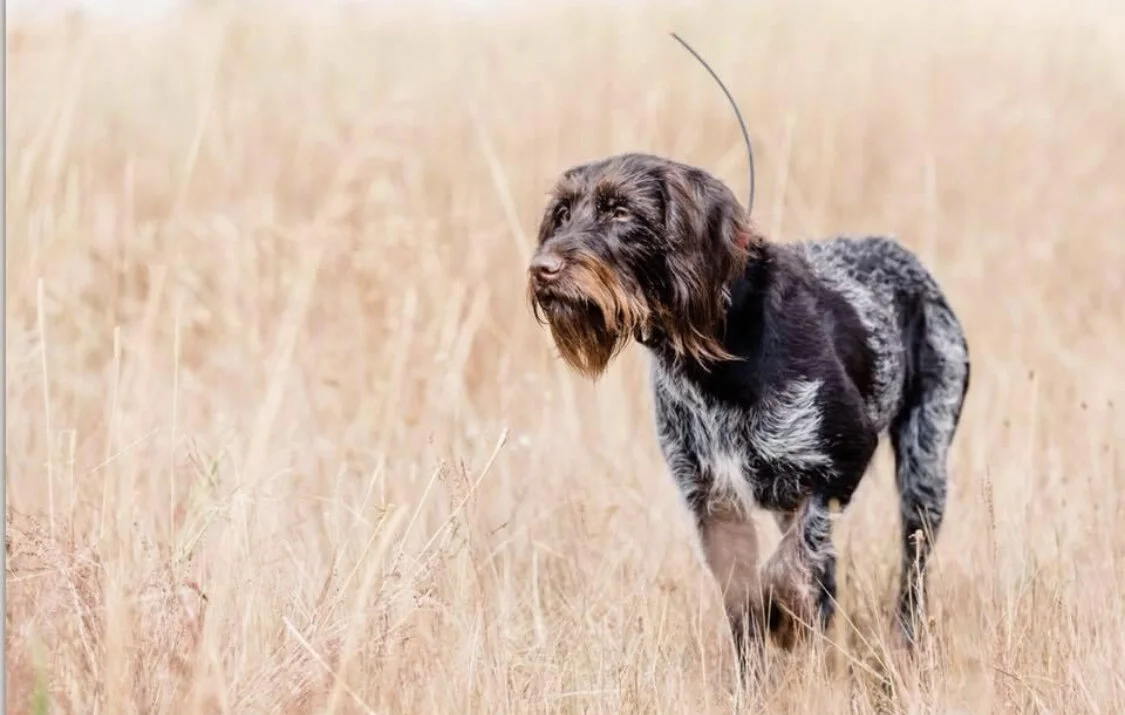About Deutsch Drahthaars
In Germany in the late 19th century, hunters sought to create a truly versatile dog: a single hunting companion that could retrieve waterfowl in frigid waters, point in the field like a setter, track and engage any size game much like a terrier, yet deliver all prey delicately to hand. The outcome was the Deutsch Drahthaar. Boasting hardiness against the elements and a legendary reputation for performance in the field, the drahthaar became Germany's most popular hunting dog.
The hunting determination and passion of the Drahthaar is unrivaled, and the best breeders have progressed in adapting to modern hunters who - depending on their area or preferred game - may require a refined pointer, an indefatigable tracker, or both.
The Deutsch Drahthaar breed authority - the Verein Deutsch Drahthaar founded in Germany in 1902 - is global in scope. Its epicenter is in Germany, with robust arms throughout Europe, Russia, and the Americas. The breeding regulations maintained by the organization are engineered to guarantee improvement of the breed with objective criteria, rigorous measurement strategies, and robust testing and documentation procedures. The most likely a prospective owner is to encounter are explained below.
Mandatory Health Requirements
Drahthaar breeders are required to document health clearances for hip dysplasia, and typically also include osteochondritis dissecans and elbow dysplasia, with the breed authority. In Deutsch Drahthaar and other breeds, always look for breeders that volunteer verifiable documentation of the health of their producers.
Hunting, Obedience, and Behavioral Requirements
There are a battery of trials, awards, and certifications designed to objectively quantify the hunting performance and behavioral characteristics of individual Drahthaar, with testing requirements to approve dogs as suitable reproducers. These include the VJP, held in the spring to test the natural or instinctual aptitude of puppies, the HZP or fall breed test, and the VGP utility test. Additional designations exist for hardness certification (härtenachweis), armbruster halt (Armbruster-Haltabzeichen), 20 and 40 hour blood tracking, dead game baying, and others. Judges at performance trials document the character of participating dogs. Drahthaar that exhibit unwarranted or excessive aggressive or anxious behavior are mandated removed from the breeding program.
These tests produce results that both rank participant dogs against the test cohort, as well as against an objective standard that remains unchanging for the population of Drahthaar.
Conformation Evaluation
There are only two opportunities for a Drahthaar to be evaluated for breed conformation. Three judges must issue a single score ranking a drahthaar's body "form" and fur (or hair) quality on a 12-point scale. 12 is the maximum possible award. (This eliminates the risk associated with systems that allow for extensive showing until enough partial judges are found to amass sufficient points for titles.) This score is typically abbreviated to "F/H 10/9" for a dog with a score of 10 for form and 9 for fur.
Owners of Deutsch Drahthaar benefit from the refinement of the genetic pool per these regulations. We encourage owners searching for their next companion of any breed to inquire into the breeding practices, regulations, and testing practices of individual prospective kennels AND their kennel clubs or breed authorities. Together, we can demand a future in which all dogs are afforded the start in life they deserve, and maximize the chances that they will achieve their full potential throughout a long, disease- and pain-free life beside their owners.
German Wirehaired Pointer?
The Verein Deutsch Drahthaar maintains the breed standard for the Deutsch Drahthaar (DD), and is the authoring club for the FCI, as well as the breed authority for all Deutsch Drahthaar worldwide. The American Kennel Club, among other kennel clubs in some countries, recognized the Deutsch Drahthaar by its directly translated English name as the German Wirehaired Pointer in the mid-1900s. The Deutsch Drahthaar and German Wirehaired Pointer breeding programs have evolved separately to date, resulting in significant discrepancies in breed standard and practices. While you can certainly find great hunting dogs in both breeds, breeding practices for the German Wirehaired Pointer are less regulated. There is no cognate global vetting of the gene pool, nor systematic proving of health and performance, and none of the accumulated refinement of genetic material that preserves and enhances the original working temperament and innate abilities in each successive generation of DD.
